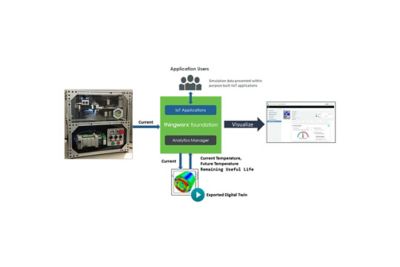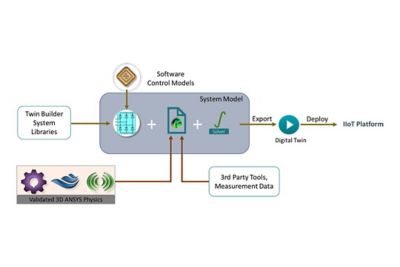-
-
학생용 무료 소프트웨어에 액세스하기
차세대 엔지니어에게 힘을 실어주는 Ansys
학생들은 세계적 수준의 시뮬레이션 소프트웨어를 무료로 이용할 수 있습니다.
-
지금 바로 Ansys에 연결하십시오!
미래를 설계하기
시뮬레이션이 다음 혁신을 어떻게 지원할 수 있는지 알아보려면 Ansys와 연결하십시오.
국가
무료 트라이얼
제품 및 서비스
학습하기
회사 정보
Back
제품 및 서비스
ANSYS BLOG
June 10, 2019
How to Quickly Create a Simulation-Based Digital Twin of an IIoT-Connected Product
Customers are demanding more from their products, pressuring manufacturers to produce faster, better designs. This trend is a major contributor to the industrial internet of things (IIoT) revolution.
Simulation-based digital twins use virtual sensors to inform
engineers about an IoT asset’s condition.
However, smart connected products are the start of this revolution. IIoT products really shine when they are connected to a simulation-based digital twin.
Digital twins are virtual representations of physical products. They have the ability to unlock value and optimization throughout a product’s lifecycle. By leveraging real-world data from IIoT-connected product and physics-based simulations, digital twins can better inform and predict product performance. This enables users to develop new designs, operations and controls to optimize performance, reduce downtime and enable service-based products — often without the customer needing to upgrade hardware.
The technology to get an IIoT digital twin running is available, however, many organizations are having a hard time implementing and connecting all of the digital, physical and data assets together. With the help of Ansys Twin Builder and PTC ThingWorx, engineers can simplify the creation of digital twins using physics-based simulations.
The Benefits of Simulation-Based IIoT Digital Twins
Many IIoT digital twins that offer predictive maintenance and analytics are based on historical data and statistical models. The challenge engineers face implementing these digital twins is that many assets, especially newer ones, do not have the historical data required to create these statistical models.
Engineers do not need historical data to create a motor’s digital twin.
Instead, Ansys Multiphysics software can perform simulations
and create virtual sensors.
Additionally, implementing a statistic-based digital twin of a legacy product requires that the data be collected and converted into a usable format. The biggest challenge is that it’s hard to collect enough data — even from legacy products — that statistically covers every possible scenario the product could face in the real world.
The advantage of physics-based digital twins is that they can supplement or replace historical data using simulations. This reduces the physical testing, data collection and data conversion required to get a digital twin off the ground. In fact, a physics-based digital twin’s ability to simulate a product’s conditions can even reduce the number of sensors needed on the IIoT device.
Now instead of waiting for enough field data to build and deploy a digital twin, engineers only need a small amount of data to validate it. This will speed up development and time to market.
How to Build a Digital Twin in Ansys Twin Builder and PTC ThingWorx
In this example, a digital twin of an electric motor will be made using Ansys Twin Builder and PTC ThingWorx.
The physical motor asset has a voltage and a current sensor. Its loads are then controlled using solenoids.
Creating a digital twin of this asset doesn’t require any sensors within the motor or on its rotor to determine its temperatures. To predict the motor’s temperature, engineers have to first develop a physical representation of the motor in Ansys Multiphysics software.
Plugging in the motor’s digital twin enables engineers to predict
its performance in the real world.
Once the modeling is completed, it is integrated into Twin Builder using a reduced order model (ROM) and used to create a digital twin of the motor.
Ansys Twin Builder workflow for developing and deploying digital twins
This digital twin can predict the motor’s current and future maximum temperature, in real time, based on the current. The digital twin can be exported and deployed on an IIoT platform, in this case PTC ThingWorx, to predict the remaining useful life of the motor for predictive maintenance purposes.
To learn how to build an IIoT digital twin in more details, watch the webinar: Product Simulation Models Incorporated into Digital Twin Applications to Accelerate Monitoring and Service.



